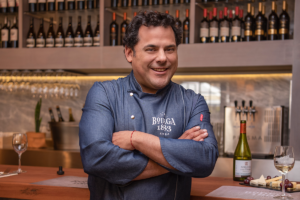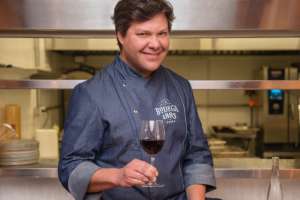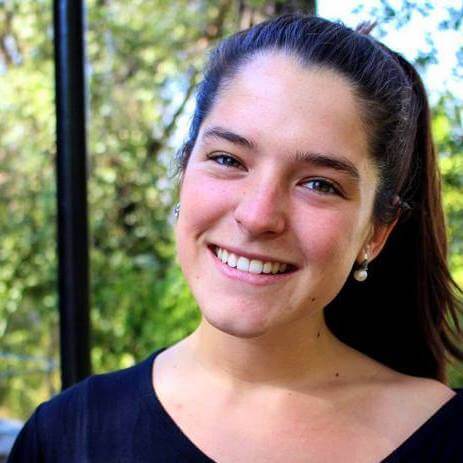We interviewed the renowned chefs in charge of the new restaurant at Concha y Toro’s Pirque Tourist Center. Read more about them in this article!
Signature cuisine is what Ismael Lastra and Tomás Saldivia are aiming to create at the new restaurant that opened in June at Concha y Toro’s Pirque Tourist Center. The two chefs have very different styles when it comes to cuisine but share the same passion, the same drive to achieve sustainability and have an innovative approach to cooking, making this unparalleled partnership.
María: How would you describe your style of cooking?
Ismael: We have a special style, it’s a mix. We are auteur chefs, there are two of us. Our work is based on respect, on empathy, and on working together to reach the final flavor rather than trying to either of egos. This is very important and is the basis of our success.
Tomás: What we do is authors’ cuisine, world cuisine. It’s about using Chilean products and helping small-time producers. We are tireless miners in search of Chile’s gold.
M: You worked in Europe, what did you learn there?
I: I learned to believe in myself, in what I can do. I learning many unimaginable techniques, discovered products and raw materials, and really got the haute cuisine bug. I learned to do bulk cooking and the cook and chill technique and how to use high-tech equipment. The best thing I learned, however, was how to chill food!
T: I worked in various parts of Europe: Croatia, Italy, Spain and Portugal. I learned to live and relish life through the work I do and love. I learned to understand other cultures, techniques and flavors and different ways of blending the same raw materials that we have in our country.
M: Doesn’t the technique mask the ingredient?
I: No, quite the opposite. It enhances it. That’s how it should be. It improves it in every way.
T: The technique enhances and transforms the same ingredient and gives it another flavor, another texture and dimension.
M: What kind of menus do you usually recommend and which dish is your specialty?
I: We are very different in that respect. I like very simple, Mediterranean, traditional food, with vegetables and fish. Tomás likes more sophisticated preparations, with sauces and food rarities. He doesn’t shy away from inventing new things. In other words, it’s a mixture of our styles.
T: I tend to highlight local produce, from my country, and recipes from my everyday life and travels. I don’t have a particular specialty. I think that in the kitchen you have to be receptive to changes, to new techniques and to always try new things.
María: When it comes to cooking, you always choose local products, why?
I: The main ingredient in our cuisine is always Chilean. We accompany it with foreign ingredients and use different techniques. In this new project we want the main ingredient to be from Puente Alto and the surrounding area… This is because we are convinced that you can find a gem in every part of Chile and we promote that. We have a commitment to our environment and to our people, we can provide employment and we can teach people how to improve a product. That will be our legacy and we can pass it on through our generous cuisine.
T: One of the defining characteristics of a restaurant is its physical location because you will get your supply of raw materials from the surrounding area. A well thought out restaurant is one where you can find as many products as possible to use in the kitchen within a 10km radius. This creates a self-sustaining local market network that coexists in the area.
M: Why did you choose Chilean signature cuisine over other international cuisines (e.g. French, Italian, etc.)?
I: Because it was important to do so. When I was traveling I was always tasting simple recipes that grabbed my attention and thinking in my mind how those same preparations would taste using Chilean ingredients. That made me think that something had to be done to showcase what we have in Chile, both in terms of ingredients and in terms of the professionals who can create rich cuisine with generous portions and using different techniques.
T: Chilean cuisine is something that I discovered later in life and every time I delved deeper into it, the more captivated I became. Then I went to Expo Milano to represent Chile and ended up falling in love with our cuisine, for its produce, the climate, its cooks and aficionados of the culture. All of those promoters of our traditional gastronomy don’t want to lose it. Chile is a great pantry for the world. I think we still have to discover it and make the most of it.
M: How important is sustainability in your cuisine?
I: Very important! Respect for the environment and your surroundings is vital nowadays. Cooking in general has a high impact on energy consumption and waste production. Those of us who are concerned about this use gastronomical high-tech (equipment to reduce energy costs that can reduce consumption of electricity, water and waste by up to 40%). The waste is composted and separated for recycling.
T: Nowadays taking care of the environment is of the utmost importance in our kitchen, as we have to give back to nature what it gives us every day. We are facing dramatic changes in the climate, so we have to learn to coexist with and take care of our planet and treat it with the utmost respect and then teach others to do the same.
M: How has the gastronomic world been transforming and been reinventing itself over the years? What role do social networks play in this?
I: It has changed a lot. Today, chefs play a vital role as influencers. Chilean cuisine has had to evolve because the market required it to. Today, Chileans go out to dine, they spend money on experiences, they compare and demand quality. People often take photographs of what they eat and share them on social networks before even trying the food… Criticism on social networks can be harsh. But, if you do a good job you can reach a large number of people at the click of a button.
T: I think that cuisine is constantly in a process of transformation and being reinvented… Social networks help a lot. If you think about it, every dish that comes out of our kitchens instantly becomes part of the social network universe, where thousands of others see our dishes or read comments about how delicious they are.
María: How would you best define Bodega 1883’s gastronomy? What differentiates this restaurant from the rest?
I: Our motto is the honesty of our work. This project has been constantly evolving ever since we started it. It has changed for the better and I believe that it will not remain static, it will continue to grow… Our cuisine pays homage to and always aims to complement wine. We are the rice on the plate next to the wine which is king. We seek to enhance and pair food and wine in a perfect way so as to provide the maximum experience.
We are different in that we have unbeatable raw materials, from the local area, that are treated with the utmost respect and cared for at all times until they reach the table along with the perfect wine. Our humble task is to provide people with the best way to end their visit to the tourist center.
T: Bodega 1883 by Áurea for me is the ultimate expression of nature, freshness and local produce. We have our own vegetable garden and complement that with products from the North and South of Chile and from the mountains and the coast. In Bodega 1883, you can breathe the wine. You can visit our superb bar and try Hor D’Oeuvres in a perfect pairing between gastronomy and Viña Concha y Toro wines. Two daring chefs are diving into this new adventure to discover the perfect pairings that will make these renowned wines stand out even more.
Identikit:
ISMAEL LASTRA

- Age: 44 years old
- Restaurant in Chile: Fuente Alemana
- Restaurant in the world: Arrokaberri
- Passion or hobby: Watching people enjoy themselves
- Time of day: The morning
- Drink: Coca Cola zero from a can with ice
- Meal: Italian Tenderloin
- Culinary memory: There are thousands, but watching my mother or grandmother cooking for many people warms my soul. Laughter around a table full of food and wine….
TOMÁS SALDIVIA

- Age: 39 years old.
- Restaurant in Chile: La Gaviota / Ana María Zúñiga / Doña Tina / Boragó /Pehumayen
- Restaurant in the world: Celler Can Roca
- Passion or hobby: Outdoor family sport / Cooking at home
- Moment of the day: Reading about cooking
- Drink: Lemonade, mint and ginger
- Meal: Cognac chicken with white rice
- Culinary memory: Risotto ready to serve to 50 people and when I tasted it, it was sweet, not salty. I wanted to kill myself! Within two minutes, we had chopped some extra vegetables, added grainy rice, modified the flavors so it tasted salty, not sweet, and added some parmesan flakes. It was a success. When the event ended, everyone praised the chef for the incredible risotto, with well-balanced flavors and al dente vegetables. I felt like a king (laughs)!
If you want to find out more about Bodega 1883 by Áurea click on the following link.

